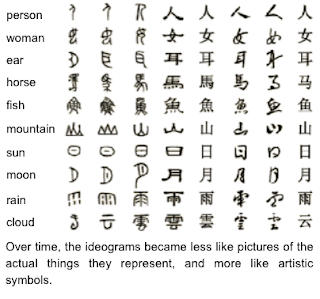Writing through the Centuries
Thousands of years ago there were no pens or pencils or paper. When ancient people wanted to leave messages, they had to carve them on wood or stone. The landscape around them was their point of reference. One of the early systems of “written” symbols were actually notched lines on tree branches or sticks that the Celtic (pronounced “Kel-tik”) people carried with them or left staked in the ground as signs. Their alphabet was called the Ogham (pronounced “oh - yum”) Sometimes these letter symbols were carved on stones or large rocks also. Originally there were only twenty letters, all consonants. Five more, representing vowels, were added sometime later. Each letter was named for a tree and stood for the first sound of its name. This Alphabet of lines was also used to “speak” with sign language. The Celts used the fingers of one hand laid across their nose or across a leg to spell out messages they didn’t want strangers in their midst to understand.
The Runic Alphabets also related to trees. Each letter was called a Rune, and stood for a particular tree as well as a sound. The letters were ordered by the trees’ seasons. There was an Elder Futhark and a more simplified Younger Futhark. Both were used for the Proto-Germanic and Norse languages.
Another Runic Alphabet was used for the Anglo Saxons, but they related their letters to a broader index of nature, rather than just the many trees of the Futhark Runes.
The Chinese people used eight sets of three lines each as symbols for things. These were the eight basic tri-grams. They combined these in sets of two to make up sixty-four more symbols of six lines each called hexagrams. As the solid and broken lines shift for each symbol, they represent the ever changing nature of life. The story goes that Emperor Fu-Hsi saw a turtle coming out of a lake, and the eight tri-grams were revealed to him from the patterns on the turtle’s shell. Then the eight tri-grams produced the sixty-four hexagrams with six lines each. Later still a calligraphy form of the symbols was created. This was a more artistic ideographic system that enlarged the original sixty-four symbols into hundreds of signs. The original sixty-four hexagrams are still recognized today as the contents of the I-Ching (pronounced “E-ching”), or Book of Changes, which is often used as a form of fortune telling. The I- Ching is really a book that talks about the continually changing nature of life and how opposite things weave a pattern of becoming and dissolving. It’s like the mountain that eventually wears away into the valley below; or the lake that gradually dries up and becomes a desert. In time, the mountain will rise again; and rains will drench the land so that the desert fills up and becomes a lake once more.
Chinese symbols represent whole words or ideas, and are therefore not a true alphabet. Chinese ideograms are both beautiful and complex. A brush and ink are used to create the artistic and flowing symbols that are drawn from top to bottom. China’s characters have evolved over time from simple lines into an intricate writing system with many hundreds of symbols. Each row below shows a Chinese character evolving. There are many dialects in the Chinese language making it difficult or impossible for people from one region of China to understand people from other different regions. Although the spoken language may not be similar or understandable between regions, the Chinese people can “read” the meaning of what’s written in Chinese no matter which dialect they speak.




No comments:
Post a Comment